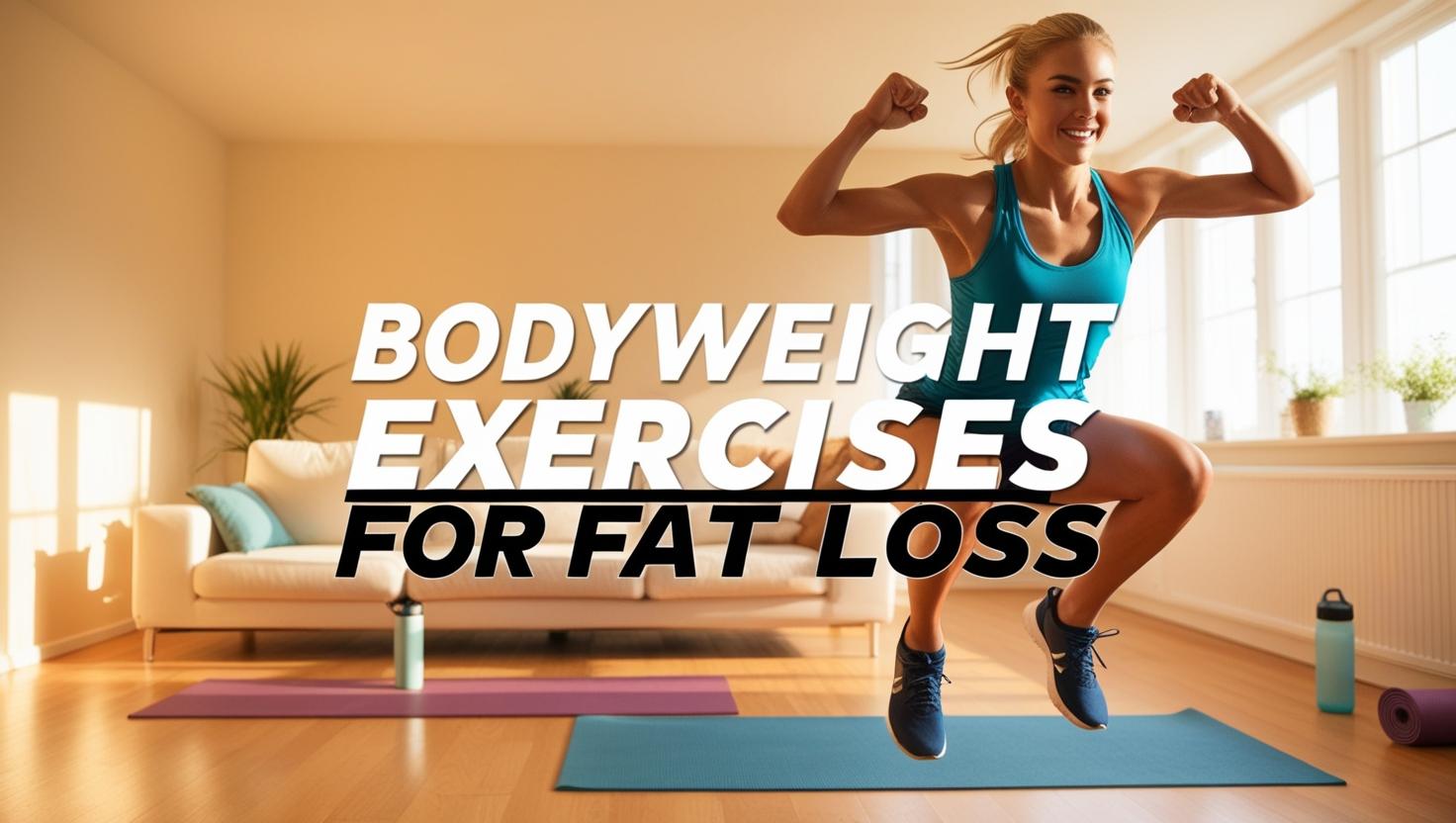Bodyweight Exercises for Fat Loss
Did you know the average person gains 3 pounds of extra fat during the winter season? If you’re looking to shed those pounds, bodyweight exercises might just be your secret weapon. These workouts use your own body as resistance to build muscle and burn fat—no gym membership required.
Think push-ups, squats, and lunges. These simple movements pack a punch when it comes to fat loss. The best part? You can do them anywhere, anytime. Whether you’re at home, in a park, or even in a small apartment, bodyweight routines are incredibly versatile.
This article will guide you through a complete list of exercises, training tips, and nutrition strategies to help you reach your goals. Let’s make strength training fun, accessible, and effective!
Introduction to Bodyweight Workouts
Bodyweight workouts rely solely on your body for resistance. No dumbbells, no machines—just you. Exercises like push-ups target your chest and arms, while squats work your legs and glutes. These moves are versatile and can be modified for any fitness level.
For example, beginners can start with knee push-ups, while advanced trainees can try one-arm variations. The key is progression. As you get stronger, you can increase the difficulty to keep challenging your muscles.
Benefits of Working Out at Home
One of the biggest perks of bodyweight workouts is convenience. You don’t need a gym membership or fancy equipment. Your living room, backyard, or even a park can become your workout space. This saves time and money, making fitness more accessible.
Another advantage is comfort. You can exercise in your pajamas if you want! Plus, working out at home eliminates the intimidation factor of a crowded gym. It’s just you, your body, and your goals.
These routines also improve balance and stability. Moves like lunges and planks engage multiple muscle groups, helping you build functional strength. Whether you’re a beginner or a seasoned athlete, bodyweight workouts can help you stay fit and healthy.
Understanding Fat Loss Through Home Training
Ever wondered how your body burns fat without fancy gym equipment? The answer lies in the science of metabolism and consistent training. Home workouts, especially those focusing on leg exercises, can be just as effective as gym sessions when done right.
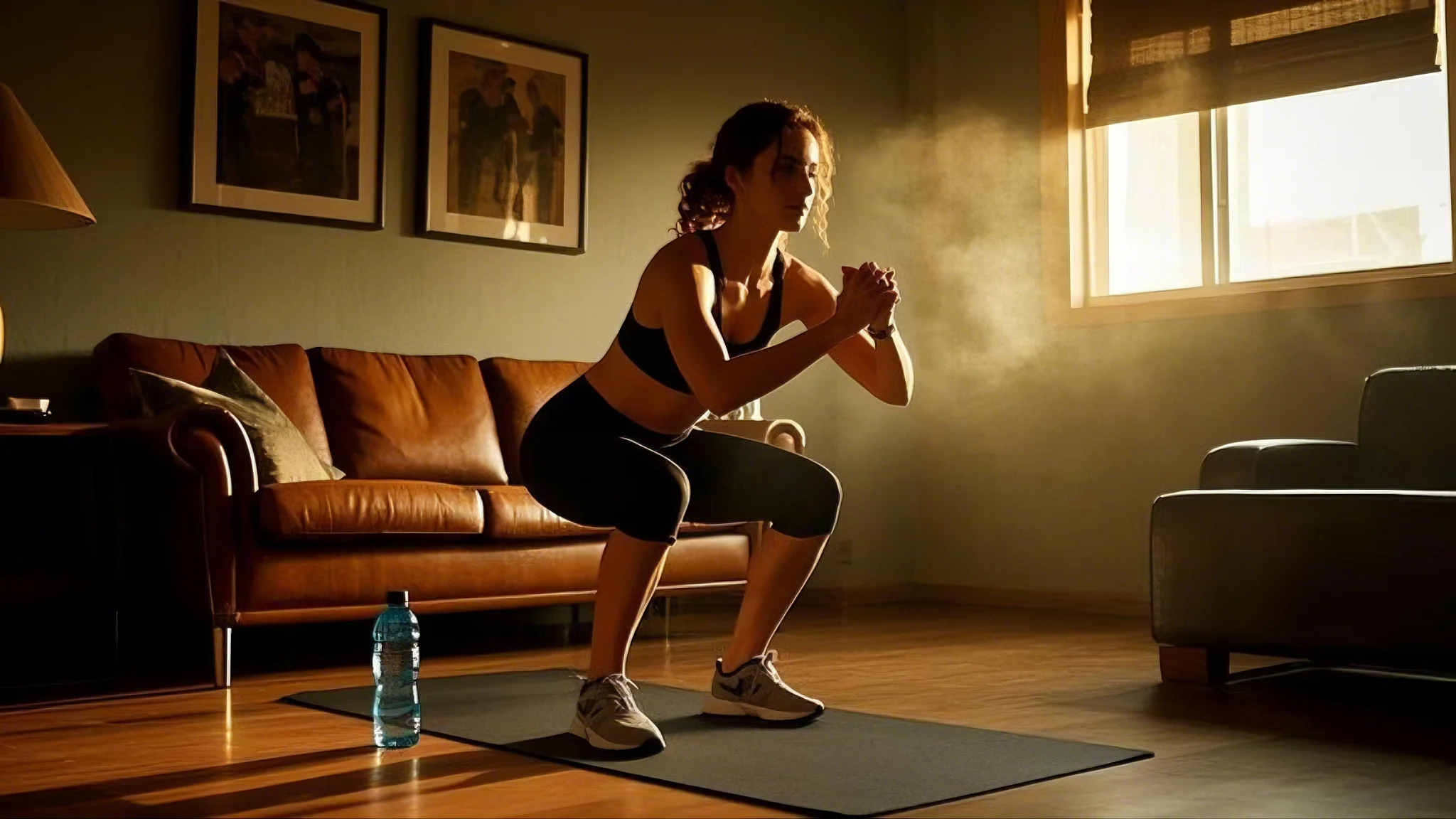
The Science Behind Fat Burning with Minimal Equipment
Fat loss happens when you burn more calories than you consume. This is called a calorie deficit. During a bodyweight workout, your body uses stored fat as energy. High-repetition, low-impact movements like squats and lunges increase your heart rate, helping you burn calories faster.
Another key factor is metabolic adaptation. As you train, your body becomes more efficient at burning fat. This means you’ll see better results over time, even with minimal equipment. For example, exercises like the Duck Walk to Squat Jump combine strength and cardio, maximizing calorie burn.
Here’s how home training stacks up against gym workouts:
| Factor | Home Training | Gym Workouts |
|---|---|---|
| Convenience | No commute, anytime access | Requires travel, fixed hours |
| Cost | Minimal to no equipment needed | Membership fees, equipment costs |
| Effectiveness | Equally effective with consistency | Effective with proper guidance |
Leg exercises play a huge role in fat loss. Moves like squats and lunges engage large muscle groups, increasing overall energy expenditure. Studies show that leg workouts can elevate your metabolism for hours after you finish exercising.
Small changes in your routine can make a big difference. For instance, adding a 10-minute bodyweight workout to your day can significantly impact your body fat percentage over time. Consistency is key—whether you’re at home or in a gym.
So, grab your water bottle, clear some space, and let’s get moving. Your fat loss journey starts right where you are!
Essential Bodyweight-Exercises for Fat Loss
Ready to shed fat with minimal equipment? These bodyweight exercises are perfect. They target multiple muscle groups, boost calorie burn, and can be done anywhere. Here’s a breakdown of the most effective moves for fat loss.
Push-Ups: A classic exercise that works your chest, triceps, and core. Keep your body in a straight line and lower yourself until your chest nearly touches the floor. Beginners can modify by dropping to their knees.
Planks: This core-strengthening move is a fat-burning powerhouse. Hold a straight-arm or forearm plank for 30 seconds, focusing on keeping your body aligned. For an added challenge, try knee drives or side planks.
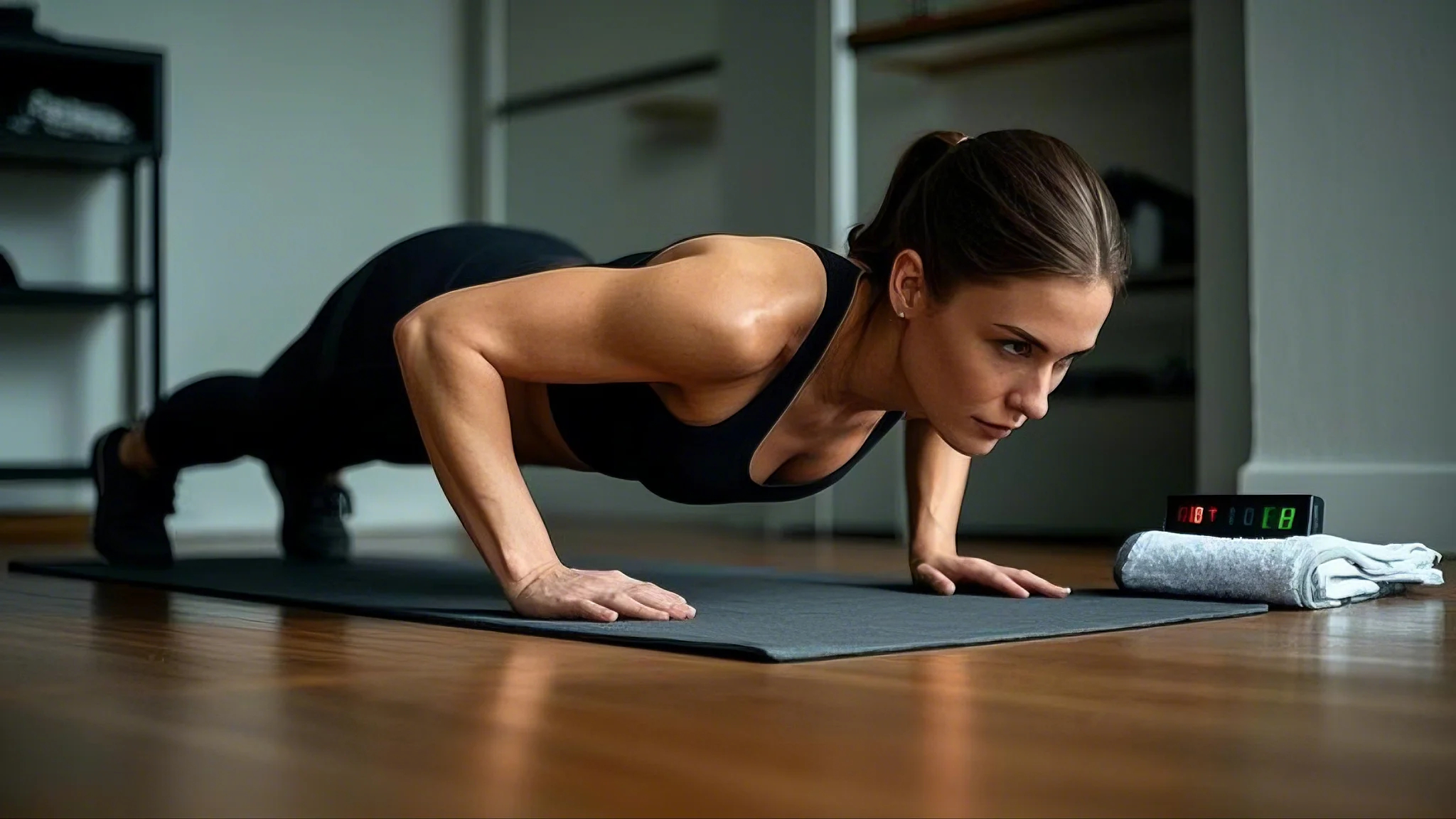
Squats: Engage your legs and glutes with this essential movement. Keep your knees aligned with your toes and lower until your thighs are parallel to the ground. Beginners can start with chair-assisted squats.
Lunges: Perfect for targeting your legs and improving balance. Step forward with one leg, lowering your hips until both knees are at 90 degrees. Alternate legs for a balanced workout.
Here’s a quick guide to reps and sets for beginners:
- Push-Ups: 2-3 sets of 10 reps
- Planks: 3 holds of 30 seconds
- Squats: 2-3 sets of 15 reps
- Lunges: 2-3 sets of 10 reps per leg
Focus on proper form to maximize results and avoid injury. For example, during push-ups, keep your core tight and elbows at a 45-degree angle. For planks, avoid sagging your hips or lifting them too high.
Modifications like knee push-ups or assisted squats make these exercises beginner-friendly. As you progress, increase intensity by adding reps or trying advanced variations. Combining these moves with calorie monitoring can optimize your fat loss journey.
Arm movements, like push-ups, paired with core stabilization in planks, improve overall strength. These exercises not only burn calories but also build lean muscle, boosting your metabolism over time.
Incorporate these essential bodyweight exercises into your routine 2-3 times a week. Consistency is key to achieving your fat loss goals. So, clear some space, grab a water bottle, and get moving!
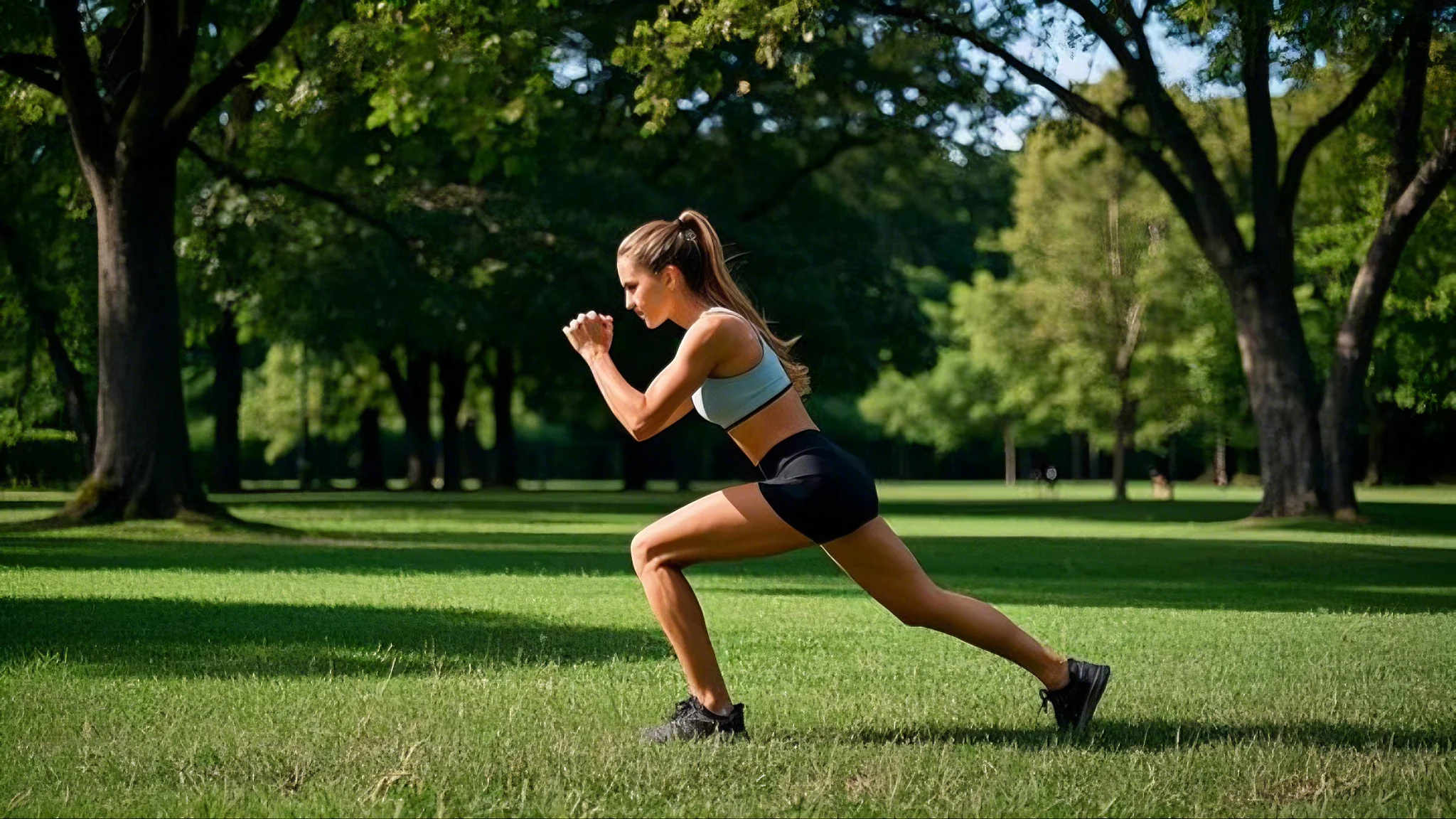
Compound Movements for Complete Fitness
Want to work smarter, not harder? Compound movements are your answer. These exercises engage multiple muscle groups at once, making your workouts more efficient and effective. Whether you’re aiming for fat loss, strength, or overall fitness, compound exercises are a game-changer.
Think of them as multitasking for your muscles. Instead of isolating one area, compound movements like lunges and squats work your legs, glutes, and even your core. This not only saves time but also boosts calorie burn and builds functional strength.
Lunges, Squats, and Their Variations
Lunges and squats are staples of any fitness routine. They target your lower body while engaging your core for stability. Start with basic squats: feet shoulder-width apart, lower until your thighs are parallel to the ground, then push back up. For lunges, step forward with one leg, lowering your hips until both knees are at 90 degrees.
Variations keep things interesting and challenging. Try side lunges to work your inner thighs or jump squats for a cardio boost. These tweaks prevent plateaus and keep your muscles guessing.
Pushups and Inverted Rows for Upper Body Strength
Pushups are a classic compound exercise that works your chest, triceps, shoulders, and core. Keep your body in a straight line and lower yourself until your chest nearly touches the floor. Beginners can modify by dropping to their knees.
Inverted rows are another great option. Using a sturdy bar or table, pull your chest toward the bar while keeping your body straight. This move strengthens your back, biceps, and shoulders, improving posture and upper body strength.
Here’s a quick guide to combining these exercises for a full-body workout:
| Exercise | Muscles Worked | Reps |
|---|---|---|
| Squats | Legs, Glutes, Core | 15 |
| Lunges | Legs, Glutes, Core | 10 per leg |
| Pushups | Chest, Triceps, Shoulders, Core | 10 |
| Inverted Rows | Back, Biceps, Shoulders | 12 |
Complete fitness comes from combining lower and upper body exercises. These compound movements not only build strength but also improve coordination and balance. So, grab your water bottle, clear some space, and let’s get moving!
Dynamic Core Moves to Energize Your Routine
A strong core isn’t just for athletes—it’s essential for everyday fitness. Whether you’re lifting groceries or perfecting your lunge, your core plays a vital role. It supports your upper body, improves posture, and enhances overall fitness. Let’s explore some dynamic moves to energize your routine.
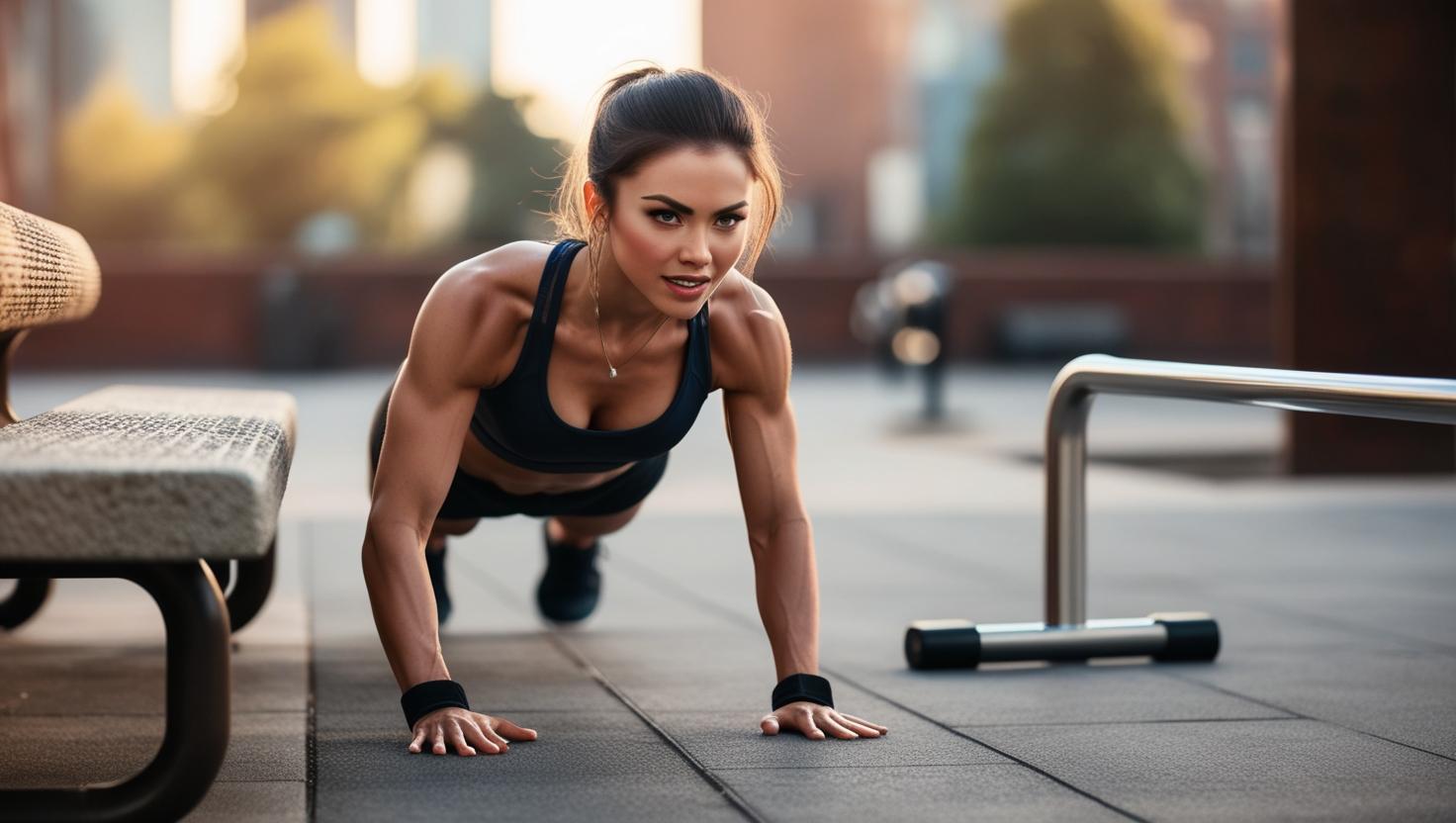
Core Stabilization Techniques
Core stabilization is all about balance and control. Exercises like the hollow hold and plank teach your body to maintain proper posture. These moves engage your deep core muscles, which are crucial for stability.
For example, try holding a plank for 30 seconds. Focus on keeping your body in a straight line. Over time, you’ll notice improved balance and strength. Adding variations like side planks or knee drives can keep things challenging.
Effective Ab Burn Strategies
Want to feel the burn? Dynamic moves like mountain climbers and Russian twists target your abs from every angle. These exercises not only sculpt your core but also boost calorie burn.
Here’s a quick ab routine to try:
- Mountain Climbers: 30 seconds
- Russian Twists: 15 reps per side
- Bicycle Crunches: 20 reps
These moves engage your upper body and core simultaneously, making them efficient for fitness enthusiasts. For an added challenge, incorporate a lunge twist to combine core and leg work.
Ready to take your core training to the next level? Check out this 20-minute core workout for a full-body boost. Your core will thank you!
Cardio-Intensive Bodyweight Workouts
Looking to boost your heart rate and burn fat fast? Cardio-intensive bodyweight workouts are here to save the day. These high-energy moves elevate your heart rate quickly, making them perfect for fat loss and cardiovascular health.
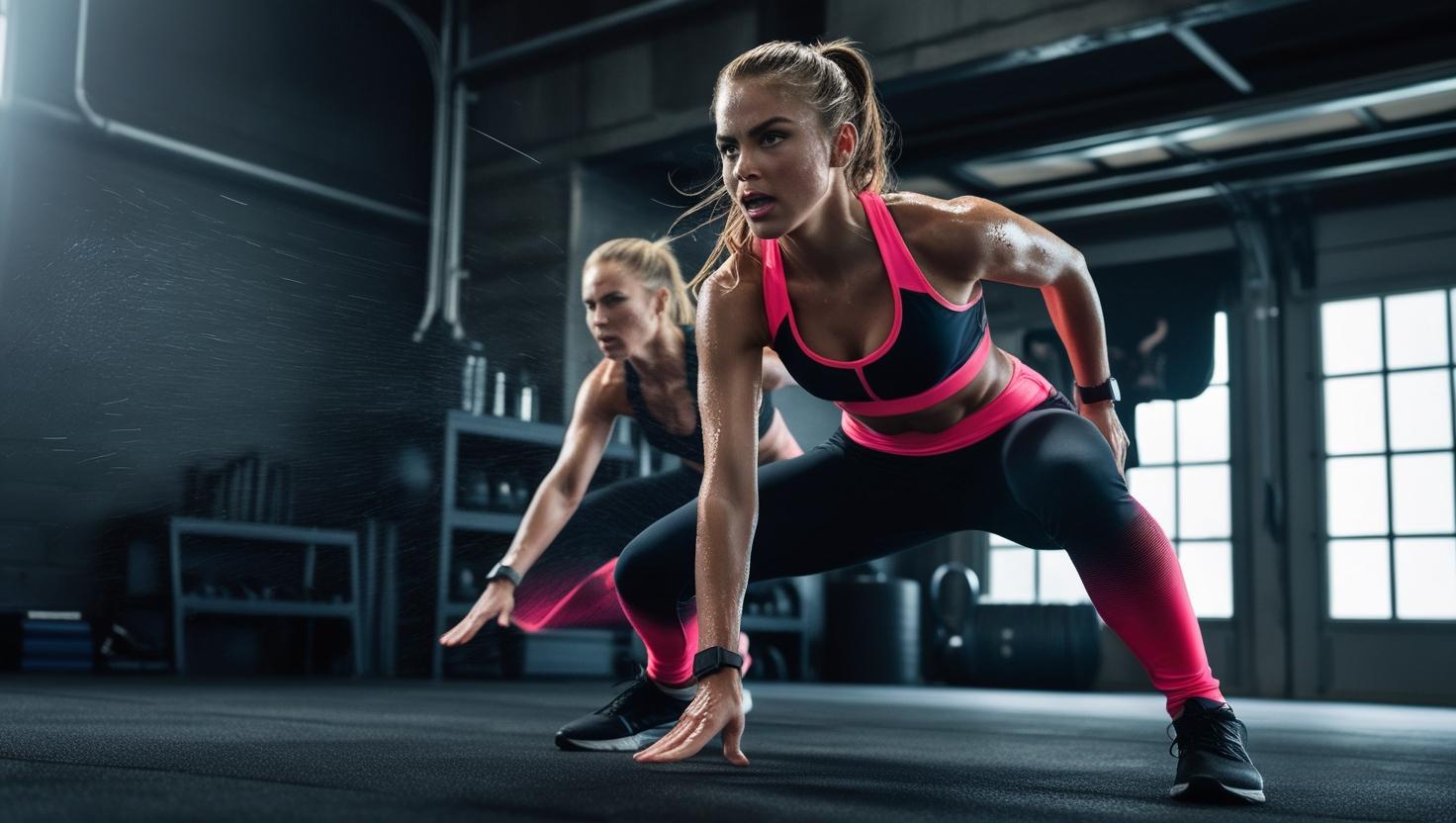
Burpees and Jump Squats for High-Intensity Cardio
Burpees and jump squats are two of the most effective cardio exercises. They combine strength and endurance, making them ideal for burning calories. Here’s how to do them right:
- Burpees: Start in a standing position, drop into a squat, kick your feet back into a plank, do a push-up, jump your feet back to your hands, and explode into a jump. Repeat for 30 seconds.
- Jump Squats: Stand with feet shoulder-width apart, lower into a squat, then jump as high as you can. Land softly and repeat for 30 seconds.
These moves are not just about speed—they’re about form. Proper technique ensures you get the most out of each rep while minimizing injury risk.
Benefits of High-Intensity Cardio
High-intensity cardio workouts like burpees and jump squats offer significant benefits. They torch calories, improve cardiovascular health, and boost metabolism. Even short bursts of these exercises can yield great results over time.
Adding variation to your routine keeps things fresh and challenging. For example, try alternating between burpees and jump squats in a timed circuit. This not only prevents monotony but also keeps your body guessing.
Group Workouts for Added Motivation
Working out in a group can add a competitive edge to your routine. Whether it’s with friends or in a virtual class, group workouts make high-intensity cardio more fun and motivating. Plus, a little friendly competition can push you to work harder.
Here’s a quick comparison of burpees and jump squats:
| Exercise | Primary Muscles Worked | Calories Burned (per 10 mins) |
|---|---|---|
| Burpees | Full Body | 100-150 |
| Jump Squats | Legs, Glutes | 80-120 |
Incorporate these cardio-intensive moves into your routine 2-3 times a week. With consistency and the right approach, you’ll see noticeable improvements in your fitness and fat loss goals. So, lace up your sneakers and get ready to sweat!
Beginner Bodyweight Workout Routines for Home
Starting a fitness journey at home doesn’t have to be overwhelming—begin with these simple routines. Whether you’re new to exercise or just getting back into it, these beginner-friendly moves are designed to build strength and confidence. The best part? You don’t need any equipment.
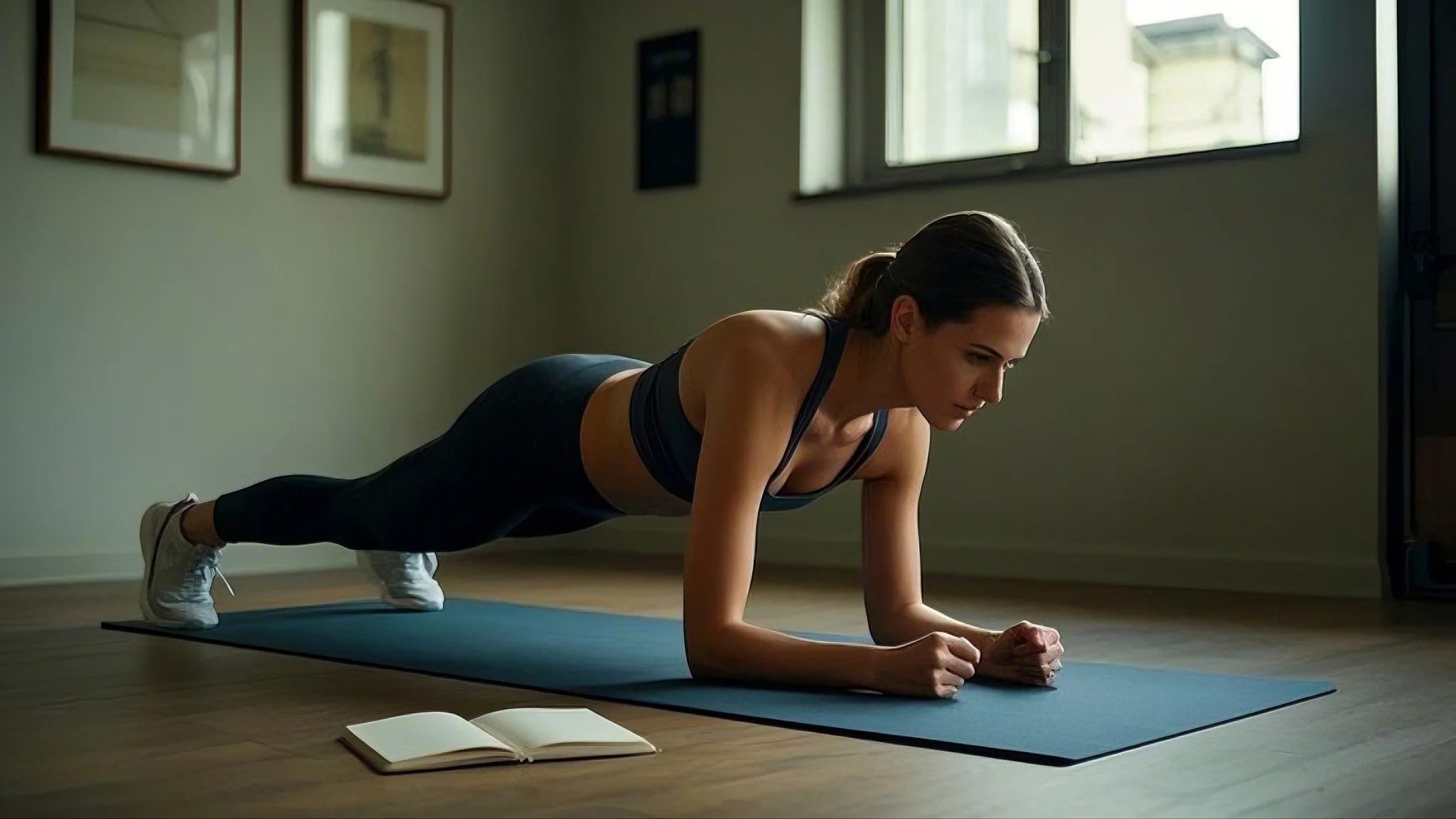
Starting with Simple Movements
Begin with basic exercises like squats, pushups, and lunges. These moves target multiple muscle groups and are easy to modify for any fitness level. Focus on proper form to avoid strain on your lower back and shoulder alignment.
Here’s a simple 3-circuit routine to get you started:
- Bodyweight Squats: Stand with feet shoulder-width apart, lower until thighs are parallel to the ground, then push back up. Aim for 10-15 reps.
- Pushups: Start in a plank position, lower your chest to the floor, then push back up. Beginners can do knee pushups. Try 8-10 reps.
- Lunges: Step forward with one leg, lower until both knees are at 90 degrees, then return to standing. Do 10 reps per leg.
Proper form is key. For squats, keep your knees in line with your toes. During pushups, engage your core and keep your shoulders relaxed. Lunges require a straight back to protect your lower back.
Progression Tips for Beginners
As you get stronger, gradually increase the intensity. Add more reps or try advanced variations like jump squats or incline pushups. Consistency is more important than speed—focus on quality over quantity.
Here’s a quick guide to scaling your routine:
| Exercise | Beginner | Intermediate |
|---|---|---|
| Squats | 10-15 reps | 20 reps or jump squats |
| Pushups | 8-10 reps (knee) | 12-15 reps (standard) |
| Lunges | 10 reps per leg | 15 reps or walking lunges |
Remember, fitness is a journey. Start slow, listen to your body, and celebrate small wins. With time, these simple movements will help you build strength, improve health, and boost confidence. Ready to get moving? Your home workout adventure starts now!
Progressive Variations to Challenge Your Body
Ready to take your workouts to the next level? Progressive variations are the secret to keeping your routine effective and exciting. By tweaking exercises, you can continue to build strength, burn fat, and avoid plateaus. Let’s explore how to scale up your routine for continued growth.
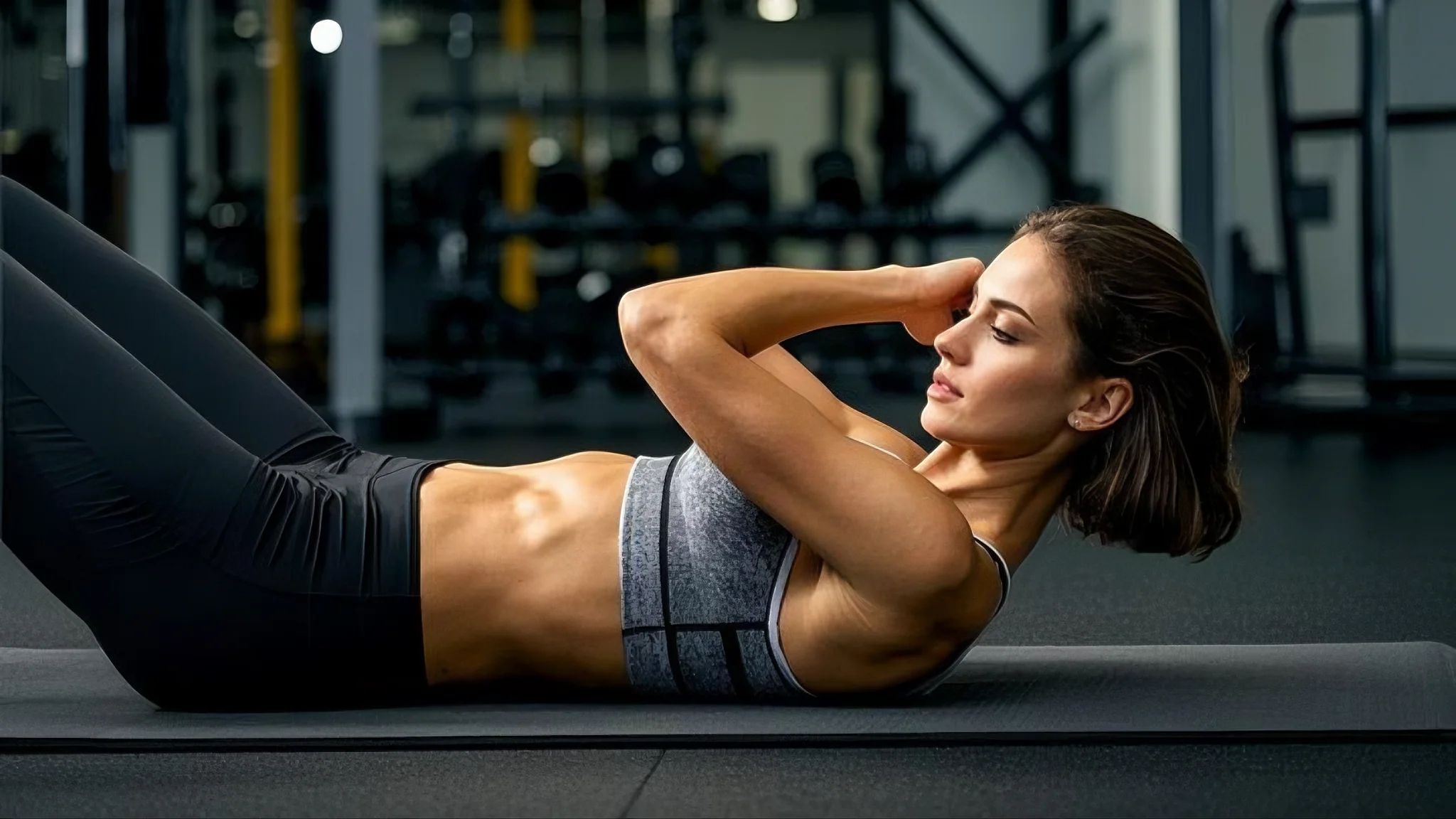
Why Progressive Variation Matters
Progressive variation keeps your muscles guessing. When you stick to the same moves, your body adapts, and results slow down. By adding challenges, you force your muscles to work harder, leading to better fat loss and strength gains.
For example, simple changes like adjusting your hip position during squats can target different parts of your lower body. This keeps your workouts fresh and effective.
Modifying Exercises for Added Challenge
Here’s how to make common exercises more challenging:
- Squats: Try single-leg squats or add a jump for extra intensity.
- Lunges: Add weights or turn them into walking lunges to engage more muscle groups.
- Pushups: Elevate your feet or try one-arm pushups to increase difficulty.
These small adjustments can make a big difference in your performance.
Focus on Hip Position and Lower Body Techniques
Your hip position plays a crucial role in exercises like squats and lunges. Keeping your hips aligned and stable improves form and prevents injury. For advanced moves, try shifting your hips slightly forward or backward to target specific muscles.
For example, a forward hip position in lunges emphasizes your quads, while a backward tilt works your glutes.
Setting Progressive Goals
Start by increasing reps or sets. Once you’re comfortable, add complex movements like plyometric jumps or isometric holds. Track your progress and celebrate small wins along the way.
Remember, progression isn’t about speed—it’s about consistency and proper form. For more tips on progressive variations in bodyweight exercises, check out this guide.
With these strategies, you’ll keep your workouts challenging and rewarding. So, grab your water bottle, clear some space, and let’s push your limits!
Training Tips: Warm-Up and Recovery Essentials
Warm-ups aren’t just a formality—they’re your secret weapon for better workouts. Whether you’re a beginner or a seasoned athlete, preparing your body properly can make all the difference. A good warm-up primes your muscles, enhances stability, and reduces the risk of injury. Let’s dive into how to start strong and finish even stronger.
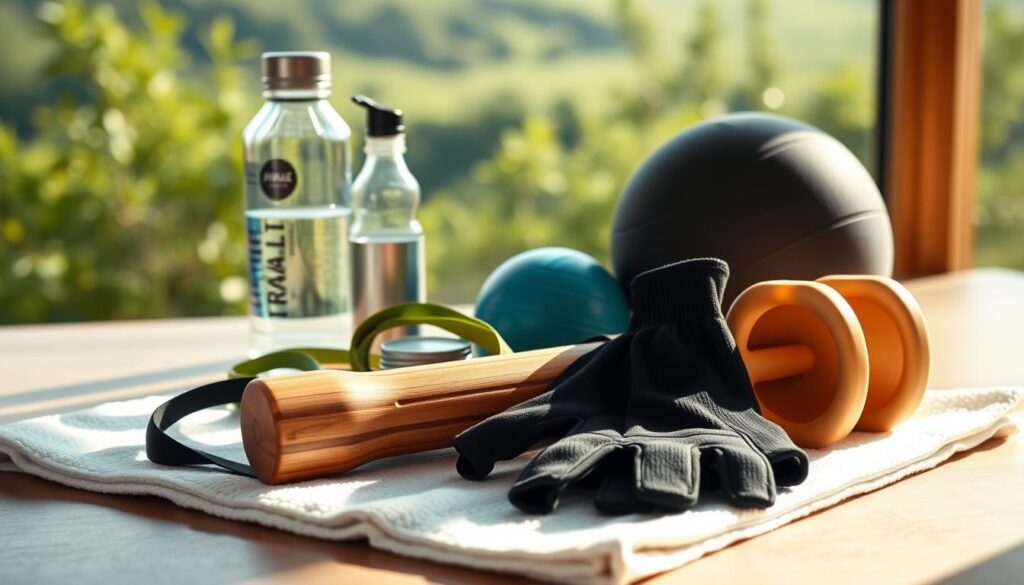
Dynamic Warm-Up Routines to Prepare Your Muscles
Dynamic warm-ups are all about movement. Unlike static stretches, these routines get your blood flowing and muscles ready for action. Start with glute activation exercises like hip circles or glute bridges. These moves not only wake up your lower body but also improve your form during workouts.
Here’s a quick warm-up routine to try:
- Leg Swings: Stand on one leg and swing the other forward and backward. Do 10 reps per leg.
- Arm Circles: Extend your arms and make small circles, gradually increasing the size. Do 15 reps in each direction.
- Bodyweight Squats: Perform 10 squats to activate your legs and core.
These exercises prepare your body for more intense moves, ensuring you’re ready to perform at your best.
Cool Down and Stretching for Optimal Recovery
Recovery is just as important as the workout itself. Cooling down helps your heart rate return to normal and prevents muscle stiffness. Start with light cardio, like walking in place, followed by stretching. Focus on major muscle groups, especially your glutes and hamstrings.
Here are some effective stretches:
- Hamstring Stretch: Sit on the floor with one leg extended. Reach for your toes and hold for 20 seconds per leg.
- Hip Flexor Stretch: Kneel on one knee and push your hips forward. Hold for 20 seconds per side.
- Child’s Pose: Sit back on your heels and stretch your arms forward. Hold for 30 seconds.
These stretches improve flexibility and reduce soreness, helping you recover faster.
Remember, warm-ups and cool-downs aren’t optional—they’re essential. For beginners, they build confidence and prevent injuries. For experienced athletes, they enhance performance and longevity. So, take the time to prepare and recover properly. Your body will thank you!
Designing a Balanced Home Workout Plan
Creating a workout plan at home doesn’t have to be complicated—let’s simplify it. A balanced routine combines strength, cardio, and flexibility to keep your body challenged and your progress steady. The key is symmetry. Focus on proper form, like maintaining your elbow alignment during push-ups and keeping your balance during lunges. This ensures you’re working all muscle groups evenly.
Start by mixing upper and lower body movements. For example, pair squats with push-ups to engage your legs and arms in one session. This prevents overtraining one area and keeps your workouts efficient. Here’s a simple framework to follow:
- Strength: Bodyweight squats, push-ups, and planks.
- Cardio: Jumping jacks, burpees, or mountain climbers.
- Flexibility: Hamstring stretches, hip flexor stretches, and child’s pose.
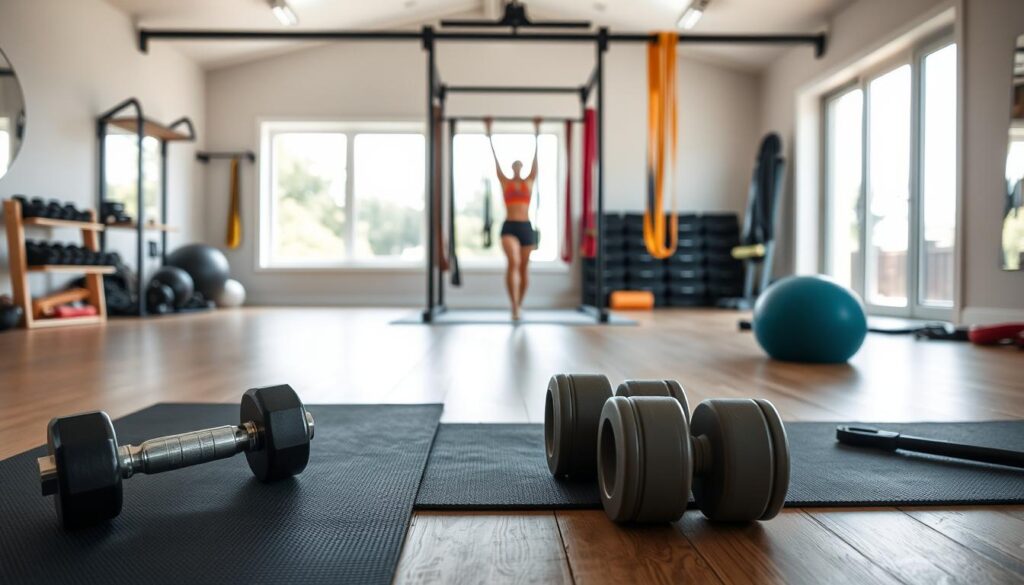
Timing Your Workouts
Timing is crucial for a balanced routine. Aim for 30-45 minute sessions, including warm-ups and cool-downs. Here’s a sample schedule:
| Activity | Duration |
|---|---|
| Warm-Up | 5 minutes |
| Strength Training | 15 minutes |
| Cardio | 10 minutes |
| Flexibility | 10 minutes |
| Cool-Down | 5 minutes |
Customize your plan based on your goals and fitness level. Beginners can start with shorter sessions and fewer reps, while advanced trainees can increase intensity. Remember, consistency is more important than perfection. A well-rounded routine not only builds strength but also improves overall health and endurance.
Don’t forget to listen to your body. If you feel pain or discomfort, adjust your form or take a break. Proper elbow positioning and maintaining balance are essential to avoid injury. With these tips, you’ll create a sustainable workout plan that fits your lifestyle and keeps you motivated.
Nutrition Strategies for Maximizing Fat Loss
What if the missing piece to your fat loss puzzle is on your plate? While bodyweight exercises are a powerful tool, they’re only part of the equation. Pairing your workouts with the right nutrition can take your results to the top. Let’s explore how to fuel your body for performance, recovery, and fat loss.
Eating for Performance and Recovery
Your body needs the right fuel to perform and recover. Focus on balanced meals that include lean proteins, healthy fats, and complex carbs. For example, grilled chicken with quinoa and roasted veggies is a great way to refuel after a workout. Protein helps repair muscles, while carbs restore energy levels.
Don’t forget snacks! A handful of nuts or a piece of fruit can keep your energy steady throughout the day. These small steps make a big difference in how you feel and perform.
Calorie Management and Portion Control
Managing calories doesn’t mean starving yourself. It’s about making smart choices. Start by using smaller plates to control portions. This simple step can help you eat less without feeling deprived.
Track your meals to stay on target. Apps like MyFitnessPal make it easy to log what you eat. This way, you can ensure you’re in a calorie deficit without overdoing it.

| Meal | Calories | Example |
|---|---|---|
| Breakfast | 300-400 | Oatmeal with berries |
| Lunch | 400-500 | Grilled chicken salad |
| Dinner | 500-600 | Salmon with sweet potato |
| Snacks | 100-200 | Apple with almond butter |
For more detailed nutritional strategies for fat loss, check out this resource. It’s packed with tips to help you stay on track.
Remember, making smart food choices is the top priority. Whether it’s choosing whole grains over refined carbs or opting for water instead of sugary drinks, every decision counts. Your arm and leg workouts will thank you when they’re fueled with the right nutrients.
Wrapping Up Your Bodyweight Transformation Journey
Your fitness journey doesn’t need fancy tools—just your body and determination. Throughout this article, we’ve explored how simple movements like squats, push-ups, and lunges can transform your fitness level. These exercises require minimal equipment, making them accessible for everyone, whether you’re at home or on the go.
Consistency and creativity are key. By mixing up your routines and challenging yourself, you’ll see steady progress. Pair your workouts with smart nutrition strategies to maximize fat loss and energy. Remember, every small step counts toward your goals.
Success stories and expert tips show that anyone can achieve results with dedication. Whether you’re a beginner or advancing to the next level, your body is the best equipment you have. Keep pushing forward, and don’t let a lack of equipment hold you back.
Ready to take the next step? Explore more routines and expert advice to keep your journey exciting and effective. Your transformation is just a workout away!
